Abstract: Japan’s “lost decade” has turned into two; and Japan is not alone. Staggering amounts of public debt and stagnant economies have become a problem from the EU to the U.S. Despite twenty years of evidence to the contrary, the belief persists that deficit spending stimulates the economy. In Japan’s case, a low return on capital from massive, low-yield government borrowing all but ensures very weak growth. The borrowing must be halted by cutting spending, in particular by sharply reducing subsidies, transfers to local governments, and pensions for those who are plainly able to work.
Japan’s “lost decade” is no longer one, but two. And it has company. Stagnant economies and staggering amounts of public debt have become a problem from the EU to the U.S. If Japan finally made headway on its economic woes, it could provide a blueprint for others in similar situations.
Unfortunately, such progress appears unlikely. Japan has struggled with political obstacles to debt reduction, as many other countries are now. There is a widespread belief, clung to despite all evidence to the contrary, that deficit spending stimulates economic growth. This must be dispelled in order for Japan or any country to take the necessary fiscal steps toward recovery.
Japan’s fall from economic leadership in the early 1990s was not at all due to fiscal policy. The ensuing years of stagnation and decline in comparative living standard, though, are intertwined with fiscal failure. With a shrinking labor force and limited land endowment, Japan cannot grow while the return on capital is low and innovation is weak. Yet this is exactly what to expect from an excessive state role in the economy and mass government borrowing at near-zero interest rates.
Structural reforms are indispensable to Japan’s future—to encourage innovation, among other goals. These are critical issues deserving of extensive discussion. For the present, however, bond sales must be slashed in order to raise the return on capital. Change is daunting due to the size of the annual budget deficit and the debt.
Eliminating the deficit is clearly more important than precisely how it is eliminated. A good place to start is the budget’s “special” account, which overlaps with the general account but covers more spending and is a better tool for budget assessment. Given the level of debt, transfers to local governments and state intervention in the economy through subsidies are especially inappropriate. Each should be sharply reduced. Deep cuts will permit moderate reductions in pension spending to close the remaining deficit.[1]
One response to calls for genuine budget cuts has been to invoke Japan’s very brief attempt at fiscal discipline in 1997 as a cautionary tale. After 13 more years of stagnation, this is no longer sensible. The record says that the government continues to inhibit growth, not support it. Some will still wonder whether now is the right time for fiscal contraction, as even necessary reform is less painful when circumstances are conducive. However, conducive circumstances have come and gone for 20 years, and little has been done. If Japan does not act now, it risks falling further behind.
Keynesian Stagnation
Japan's economy is almost the same size as it was in 1992—one of the most stunning economic statistics of the past generation. It is also a glaring warning to the U.S. and other countries entering the fifth year, or more, of stagnation in real growth.[2]
This failure has multiple causes—crucial among them, a naïve faith in Keynesianism. Japanese policymakers, and some foreign observers hold a faith in Keynesian stimulus bordering on theological.[3] A narrow form of Keynesianism argues for government action at or near the time of crisis, because the private sector may be paralyzed by uncertainty. Japan’s crisis is 20 years in the past, yet Keynesian stimulus has been continuously applied since then.
The results are plain. Despite racking up the largest peacetime debt in modern economic history, while entirely failing to grow, the government continues to respond to every downturn with more stimulus. This has accomplished nothing. Yet ending large-scale deficit spending is seen as the threat to the economy. So spending continues, reform is non-existent, and Japan trudges along.
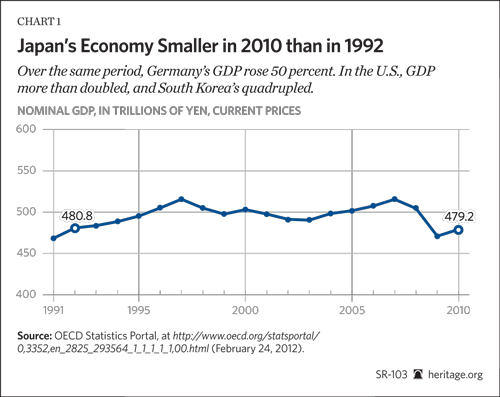
The short term is the subject of much debate but long-term economic growth is not a mystery: It stems inevitably from land, labor, capital, and innovation. Productivity from these components is the core of competitiveness; policies addressing other matters are secondary in the long term (and, in the case of the value of the yen, overrated in importance).
Japan’s labor situation is well known and challenging: An aging population naturally limits the contribution of labor to growth. Labor productivity is reasonable and labor market flexibility has improved in response to challenging conditions. However, more flexibility could generate at least a bit more growth. Employment among the elderly and women should be enhanced by improving conditions for part-time employment and the already growing non-traditional employment track should be better integrated with the traditional, “secure,” track.[4] Still, demographics will limit the contribution of labor.
The situation is similar for land. Japan demonstrated long before the U.S. did that higher land values are hardly a reliable means of sustaining wealth. The growth contribution of land is very likely to be small for an indefinite period, as Japan lacks natural resources with much current value, but could be improved if land was not wasted on unnecessary infrastructure projects or agricultural output that should occur overseas.
Changes in public policy could have an impact on innovation. Compared to the U.S., which relies heavily on innovation, in Japan the government plays a major role in the corporate sector and has supported corporate expansion in scale and global brand recognition, to win market share. These actions have benefits, but they may run contrary to sustained, broad innovation. Such innovation comes primarily from new, small firms that push older, stagnant firms aside (for example, the early days of Silicon Valley). It is not enough merely to have small firms; if large, inefficient firms never fail, the scope and vitality of innovation deteriorates over time. Boosting innovation is a vital topic for future research.
Perhaps the single biggest problem is the contribution of capital to growth. Japan’s relatively poor land endowment and shrinking labor endowment mean that capital must play a critical role. Fiscal policy has made it impossible for capital to drive growth.
The Heritage Foundation’s Index of Economic Freedom[5] ranks Japan as the 22nd-freest economy in the world, including a ranking of 17th for freedom from corruption. But Japan ranks a deeply disappointing 145th place for fiscal freedom (of 179 countries). Government spending and the bond sales to support it dominate domestic Japanese capital allocation. This has proved a disaster, one which should not be at all surprising.
Money to support public finance does not appear out of thin air; it is transferred from the private to the public sector. There are certain public goods—the justice system, national defense, environmental conservation—that must be collectively supplied or they will be undersupplied. Beyond those public goods, government borrowing and spending is merely relocating money. Relocation may be worthwhile, as in the case of transfer payments to the poor, but it is anti-growth.
The harm to growth is not about a higher price of capital due to government borrowing—traditional “crowding out.” Rather, it is about quantity—the Japanese government’s huge bond position distorts financial markets. In an environment of stagnation, while the private sector still has sufficient funds, the vast bulk of them are funneled to the public sector. The government has become an ever more dominant user of capital.
The natural result of increasing government monopolization is lower returns on that capital. The private sector invests for profit, which involves creating wealth and expanding. The public sector invests for many reasons, including extremely valuable goals such as reconstruction spending, but the drive to create wealth is almost non-existent. When colossal amounts of money are shifted from the private to the public sector via bond sales, there is naturally a much lower commercial return on capital economy-wide. Due to land and labor constraints, this return is vital to Japan’s economic growth. The result is that bond sales have largely blocked the economy from growing for 15 years.
Unsurprisingly in light of the results, the Keynesian view is backward. It is precisely because labor and land contribute little that the return on capital must be high for growth to occur. A burgeoning government role reduces the return on capital, so bond sales must be halted by eliminating the annual deficit. Otherwise, growth prospects are minimal.
Facing the Debt
This conclusion regarding Keynesian stagnation has been studiously avoided in part because the necessary change—aligning revenue and spending—is daunting. The official level of outstanding government debt at the end of 2011 has not yet been released, but the quadrillion-yen ($13.2 trillion at the contemporary exchange rate) mark was broken in October 2011. More than two-thirds has been accumulated since 1995, amid the permanent Keynesian “stimulus.”[6] Japanese gross domestic product (GDP) last year was approximately 495 trillion yen, so debt exceeds 200 percent of GDP, an unprecedented level for an advanced economy not presently or recently involved in war.
Among other prosperous countries, estimates by the Organization for Economic Cooperation and Development for 2011 placed Greece’s debt at 165 percent of GDP. The other high-risk countries in Europe are below 130 percent of GDP, and the heavily indebted U.S. is at 98 percent, less than half Japan’s level. As a proportion of GDP, the increment to Japan’s debt since 2007 is eclipsed only by Iceland and Ireland, which are both in crisis.[7] Japan has to this point escaped crisis and even any semblance of austerity.
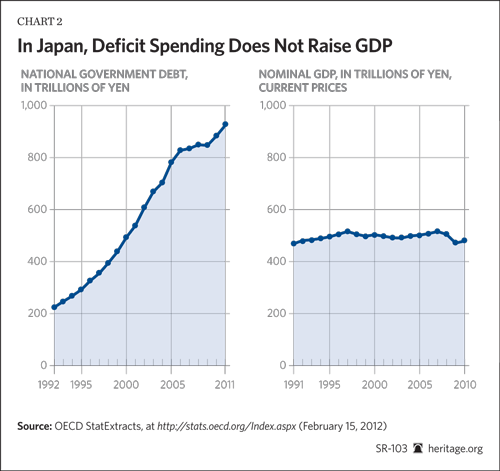
The reason for this escape is that Japan’s debt is almost entirely domestically held. The common estimate is that 95 percent is held by domestic entities, led by banks and insurers. Another way of measuring is: Almost half the debt is held by branches of the national government, led by the postal bank, the main pension fund, and the Bank of Japan itself.[8]
The fact that the debt is held domestically is a weakness, not a strength. The government branches, especially, make for a captive audience. The sustained low yield on government bonds—barely above 1 percent—then ensures that the overall domestic return on capital is very low.[9] With the long-term contribution of both labor and land constrained, the yield on capital is a major determinant of growth. Hence, through the low-cost, purely domestic financing of public debt, Japan can only be killing its own economic growth.
The solution is to halt bond sales. This is not a direct interest rate hike but an end to the diversion of capital to public finance, letting rates move without the massive distortion inflicted by the government. It also answers the question of whether now is the time for reform. On the monetary side, the risk of rates rising might be seen as prohibitive at present. This, of course, has been said for years and years. The financial crisis is more than three years in the rearview mirror. For two decades, monetary policy has been subjugated to fiscal policy—low yields helping the public sector (the borrower) but harming the private sector (the ultimate lender). Putting the public sector first has clearly failed.
There are also risks in fiscal reform. It will be a major shock to a market accustomed to an endless stream of debt accumulation. But was the 1997 recession and fall of the government worse than stagnation and fall the of many other governments between 1998 and 2011? The 1997 fiscal contraction occurred after five years of failed stimulus when Japan was still the second-richest major economy. The 12 years since translate to regression when compared to the advance in global living standards.
In 1992, for example, it seemed impossible that South Korea would become richer than Japan. Now it seems inevitable. Japan’s true options are more of the slow decline in living standards or perhaps a sudden one, from a default. The true risk of cutting the budget is just that the same result occurs more quickly.
The problem is both huge in scale and structurally embedded, so cutting the budget will be a painful process. Discussions of a “primary” deficit, which excludes debt payments, are political fantasy—it hardly matters whether bond sales are conducted to finance current government activity or to cover previous bond sales. They still drain capital from the private sector at almost zero yield. The entire deficit must be closed otherwise Japan is doomed to stagnation or decline.
The true deficit in the next budget will be approximately 44 trillion yen ($540 billion),[10] 9 percent of GDP. This is the optimistic view. Nearly half of spending is financed by borrowing, not taxes, suggesting the budget is twice as large as it should be.[11]
Taxes Less Important
One side of the fiscal equation is taxes. There has been a good deal of attention paid in Japan to raising taxes, but that is not the solution to the fiscal mess.
There are different ways to tax, and therefore different ways to measure the tax burden. Japan still has net national savings, though these have declined, and can afford to raise taxes in that basic sense. The long excessive corporate tax rate has been addressed in principle by a considerable reduction. The next step should be broadening the tax base, as the number of firms that actually pay is too small.
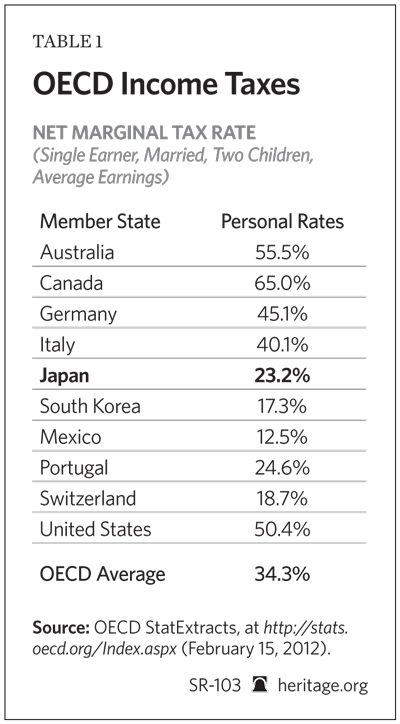
Simple measures of income tax rates, as well as more comprehensive effective taxes on labor, are low in comparison to those of most advanced economies.[12] One way to cut the deficit, and reduce the amount of money transferred from the private sector to the public sector via bond sales, is thus a phased-in tax increase on individuals. The present and previous governments have proposed higher consumption taxes. The current variant is to raise the 5 percent value-added tax (VAT) to 10 percent in stages by 2015.[13]
Such an increase will certainly not cause a depression. Eventually, tax revenue should rise due to economic growth and a broader base. However, there are compelling reasons why taxes should play only a minor role in addressing the fiscal disaster. One-time tax increases to pay for reconstruction spending may be reasonable but do not address the structural deficit.[14] The proposed consumption tax increase will close less than one-third of the deficit, at best. A larger tax increase in an environment of stagnation risks contributing to the exodus of private activity that now seems to be accelerating.[15]
Instead, tax policy should emphasize reform that is roughly revenue-neutral in the short term and encourages growth, in order to be revenue-positive in the long term. This is another important topic for future consideration. It is not as crucial as spending discipline, though, since Japan has long since passed the point where it can grow out of the deficit. In any case, VATs, such as the consumption tax, reduce transparency, do not qualify as pro-growth measures, and therefore are less likely to help narrow the structural deficit.
Moreover, the government’s capacity to implement tax changes appears as strained as its ability to reduce spending. Even the minor consumption-tax increase proposed by prime ministers from both parties has been discussed for years without action.[16] A larger increase would be as controversial as major spending cuts, and less helpful. The political effort required to break the status quo should be directed at the more productive matter of increasing the amount of capital used in commercial activity—by cutting spending.
Special Accounts First
Spending cuts are identified best by starting with the budget’s special account. From 1985, when the economy and fiscal situation were comparatively sound, to 2011, the general account grew by about 75 percent. This is a reasonable amount for such an extended period. The special account was already twice the size of the general account in 1985 and has more than tripled since. It is now more than four times the size of the general account.[17]
It is not at all clear why the general and special accounts are kept separately, especially since they overlap, which makes the budget far less transparent. The special account does not include certain conventional budget items, such as defense spending, but it includes many others, such as pensions. The rapid expansion of the special account suggests that the included spending is the main reason for the broadening deficit.
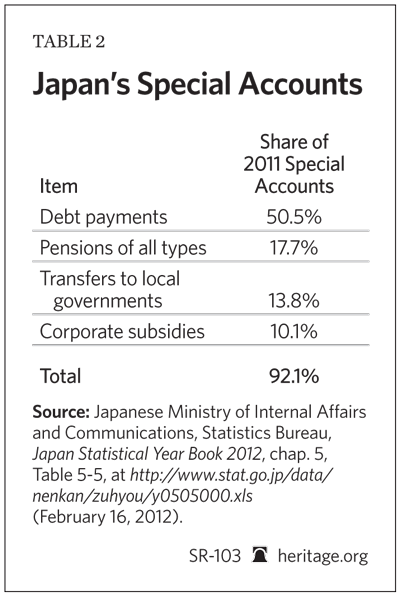
Budget analysis and reform that starts with the general account is therefore hampered from the outset. It is no mystery why recent prime ministers, at least, have not wanted to address special accounts directly—half of the fiscal year (FY) 2011 allocation went to debt payments. This is not only politically embarrassing, it is a financial challenge. The failure to act has caused more of the budget to be untouchable, and solutions to be more painful.
Even excluding debt payments, the three largest categories in the special accounts by themselves accounted for more than 40 percent of spending. Focusing on these three does not align perfectly with conventional budget categorizations, which for example emphasize social security. The three are chosen to indicate that a good deal of progress can still be made by addressing only a few programs, and despite the flexibility lost to debt payments.
They can also be separated into allocations to individuals, to local governments, and to corporate entities. Transfers to local governments are addressed in the next section. The main targets for cutting the special account are pensions and subsidies.
The shrinking of the workforce is a well-known phenomenon. Early pensions are a disincentive to work for people who are increasingly healthy and long-lived; early retirement a luxury that stopped being affordable a decade ago.[18] Revisions in eligibility requirements should be targeted at cutting the share of pensions to below 15 percent. The number is somewhat arbitrary; the measure of pensions in the special account clarifies where the cuts should occur, and the specific figure indicates they need not be too deep in proportional terms. A reduction to below 15 percent would narrow the FY 2011 deficit by almost one-fourth.
A larger dent is made by addressing various subsidies. With the economy stagnant and debt more than twice GDP, any corporate welfare is entirely unjustified. Beyond the fiscal impact, the state presence in the economy inhibits innovation and distorts resource allocation. Indeed, this is an important problem in itself, but harder to measure than the financial distortion. For the sake of both the financial and real economies, all subsidies should be eliminated as quickly as possible. Political experience argues that will be difficult, but a cut in half would save 19 trillion yen ($230 billion) in gross outlay. Combined with the pension reduction, this is equivalent to two-thirds of the deficit.
General and Local Budgeting
Unfortunately, the dominance of the special account and Japan’s bizarre budget overlap means that remaining spending is comparatively low, and finding more saving is difficult. Debt payments are still non-negotiable. A major component of social security spending is various pension programs, which overlap with the larger pension component of the special account and have already been identified for reductions.
Public-works spending is perhaps surprising. It has shrunk over the past decade and is now less than 6 percent of the general budget. Defense spending is at roughly the same level as spending for public works; perhaps unsurprising, it is also smaller than it was in 2000. Miscellaneous expenses have fallen by half since 2009, showing a bit of budget discipline.[19]
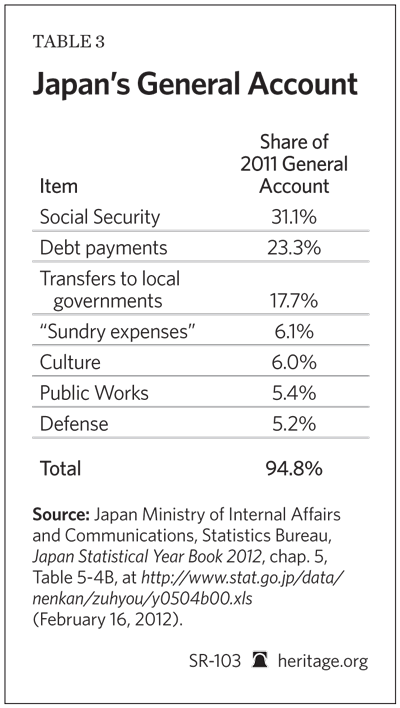
This leaves transfers to local governments. Here, the complication of overlap between the special account and general account is compounded by the usual difficulty in sorting national and local government spending. It appears that the national government provides at least 27 trillion yen ($330 billion) of local government revenue.[20]
This is a bit difficult to fathom. National disbursals to local governments take the form of paying for nationally mandated policy or supporting local spending, perhaps for political reasons. The Japanese national government is the most indebted entity in the world, yet it still plays benefactor to local counterparts. Transfers constitute an unsustainable illusion—they give ordinary citizens a false picture of the value of government programs, since they seem to be much cheaper than they actually are. Even in relatively justified cases, the national government cannot afford to support local programs, and has not genuinely been able to for years.
Transfers to local governments are a long-standing political issue, now raised again by a new political party. Local governments, in turn, demand compensating revenue in some form if spending responsibilities are decentralized. But if there is local support, they will be able to find additional tax revenue themselves. If they cannot raise the money locally, the reduction in spending will reflect the views of the people. Different administrative units have different capacities to raise funds, but this fact should be used as a reason to schedule the reductions, not to delay them indefinitely while waiting for administrative capacities to be increased.
Fiscal decentralization was considered in the past but implemented only in scattered fashion due to opposition by poorer areas. Growth has remained stagnant and the debt situation has become starkly worse. Time has run out—as much net transfer from the national government should be eliminated as quickly as possible and local spending actually determined locally. Cutting transfers in half, as an illustration, could reduce the deficit by 13 trillion yen ($150 billion).
Conclusion: Is Change Possible?
One problem in Japanese fiscal policy is what seem to be widespread delusions. They take the form of discussing how, this time, demand stimulus will boost a GDP that has not grown in almost 20 years, targeting a balance only on the general account when revenue cannot support half of total spending, or treating 1997 as more important than 1998–2011. The timing and nature of reform are difficult questions—the need for reform is not.
The proposals here are to cut pension spending somewhat, cut government support for firms deeply and immediately, and cut transfers to local governments deeply over time. Actions along these lines could reduce the annual deficit by 70 percent almost immediately and close most of the remainder over the years it will take to fully implement new eligibility rules. The remaining deficit would close as reconstruction spending falls and, indeed, could turn to a surplus. There are risks, but the alternative is another lost decade where government aims to support growth but is actually ensuring stagnation.
If Japan prevented another lost decade, its example would inevitably be emulated. Other countries would be more likely to eliminate unaffordable subsidies, to decentralize (and thus democratize) local spending, and perhaps even to address pensions before being forced to do so by bankruptcy. Japan could return to a position of international economic leadership.
No budget proposal in any country, though, can overcome systemic political breakdown. The breakdown has taken the form of both inertia and fairly open opposition. The inertia is obvious and clearly applies to high-profile budget-related reform, such as concerning the post office.[21] It also applies to pension reform, but in this proposal pension reform is not at the core of the budget fix and should not be especially onerous.
While pension eligibility is clearly a challenging issue, sharply reducing state subsidies and support for local governments do not seem quite as politically toxic. These are obvious steps to be taken by a government facing unprecedented fiscal deterioration, and offer a means of eliminating well over half the annual deficit. If they are also “impossible,” the only option may be to wait for the eventual default.[22]
The world should fear this possibility. Japan’s debt is domestic, and a default would be manageable for the international community. But Japan is not exceptional, merely further along. If Japan cannot muster the will to face its fiscal problems, it is likely that other countries will fail to do so, as well.
—Derek Scissors, Ph.D., is Senior Research Fellow in Asia Economic Policy in the Asian Studies Center at The Heritage Foundation. Kumi Yokoe, Ph.D., is Senior Visiting Fellow in the Asian Studies Center at The Heritage Foundation.


